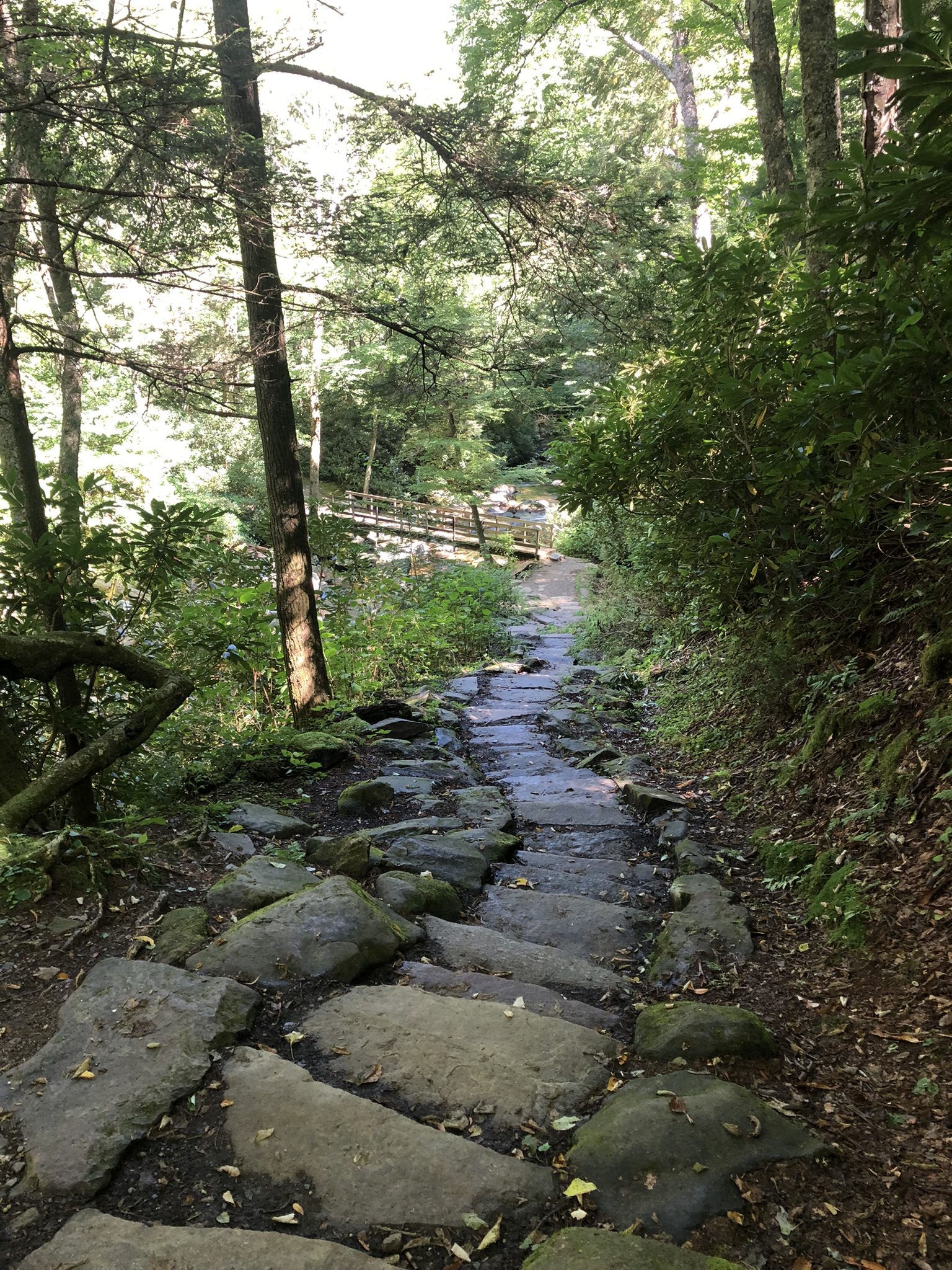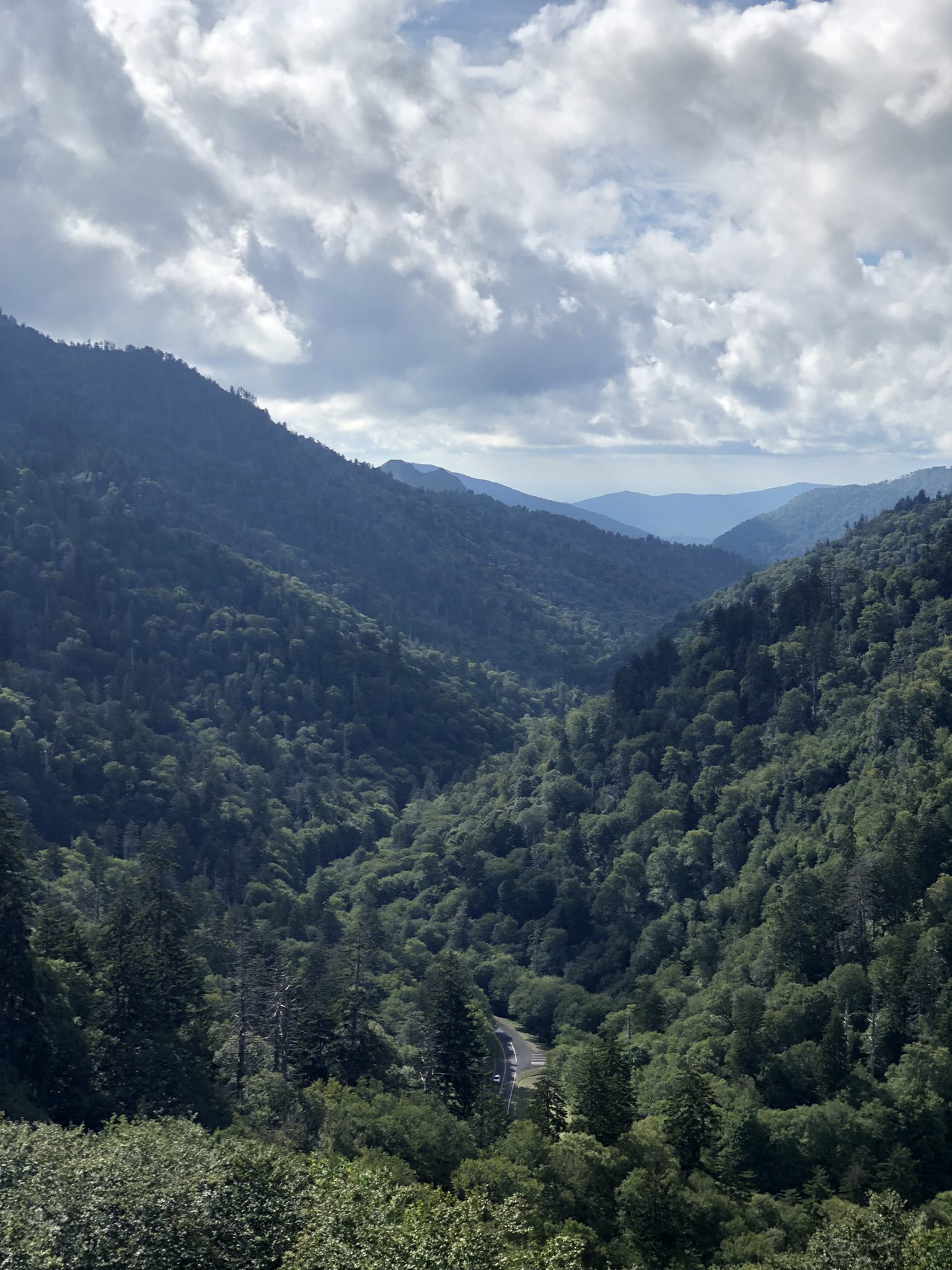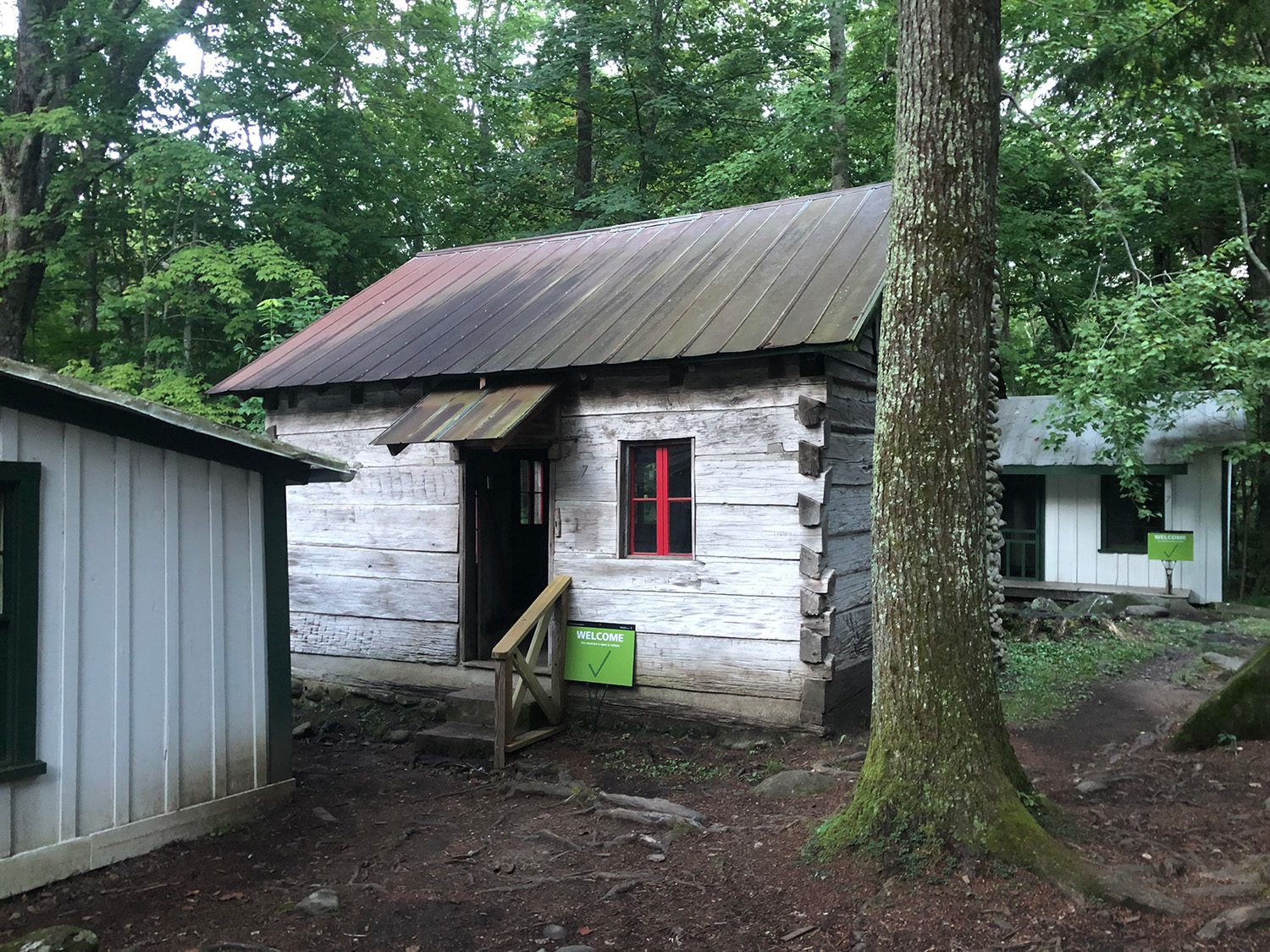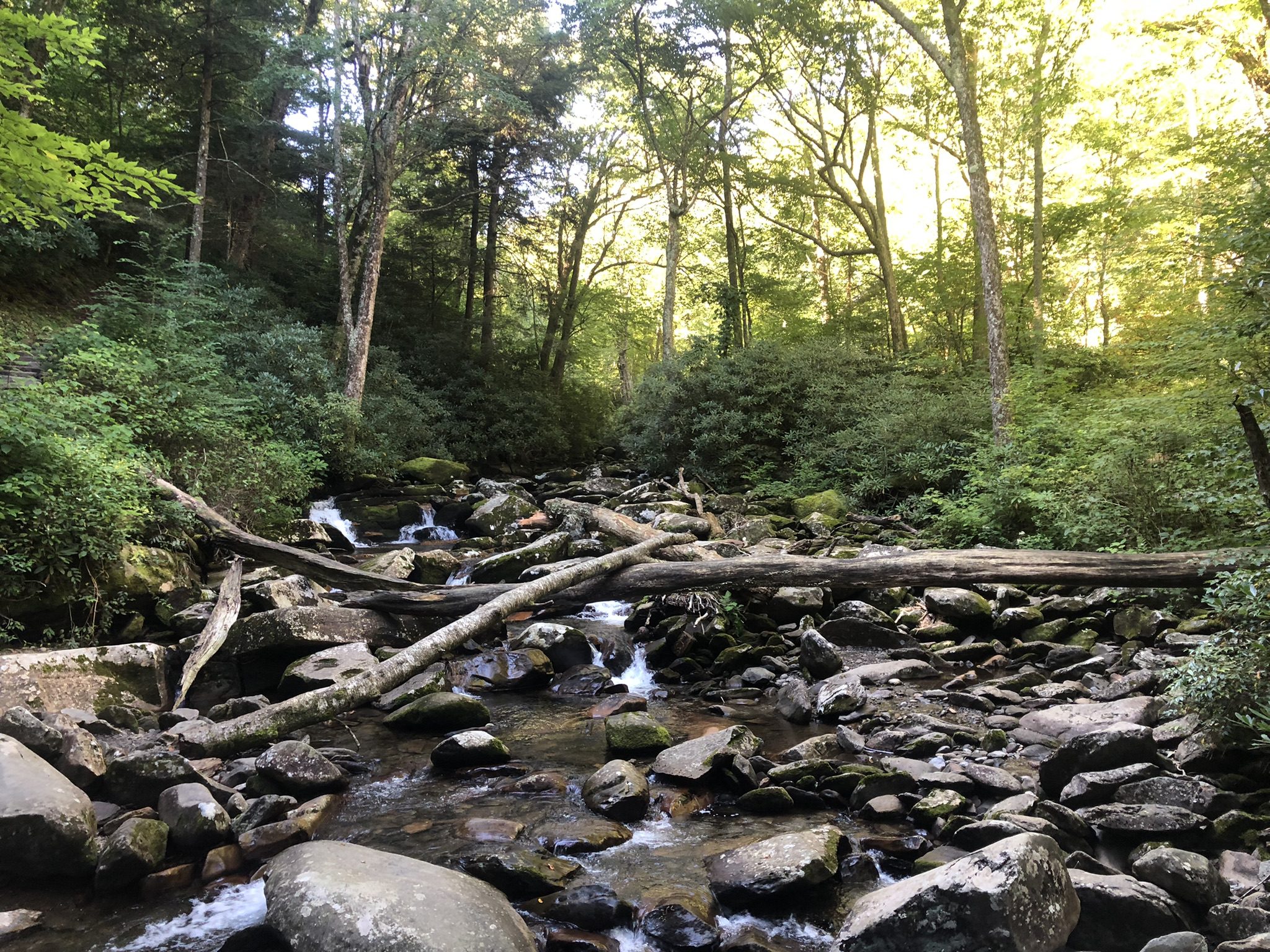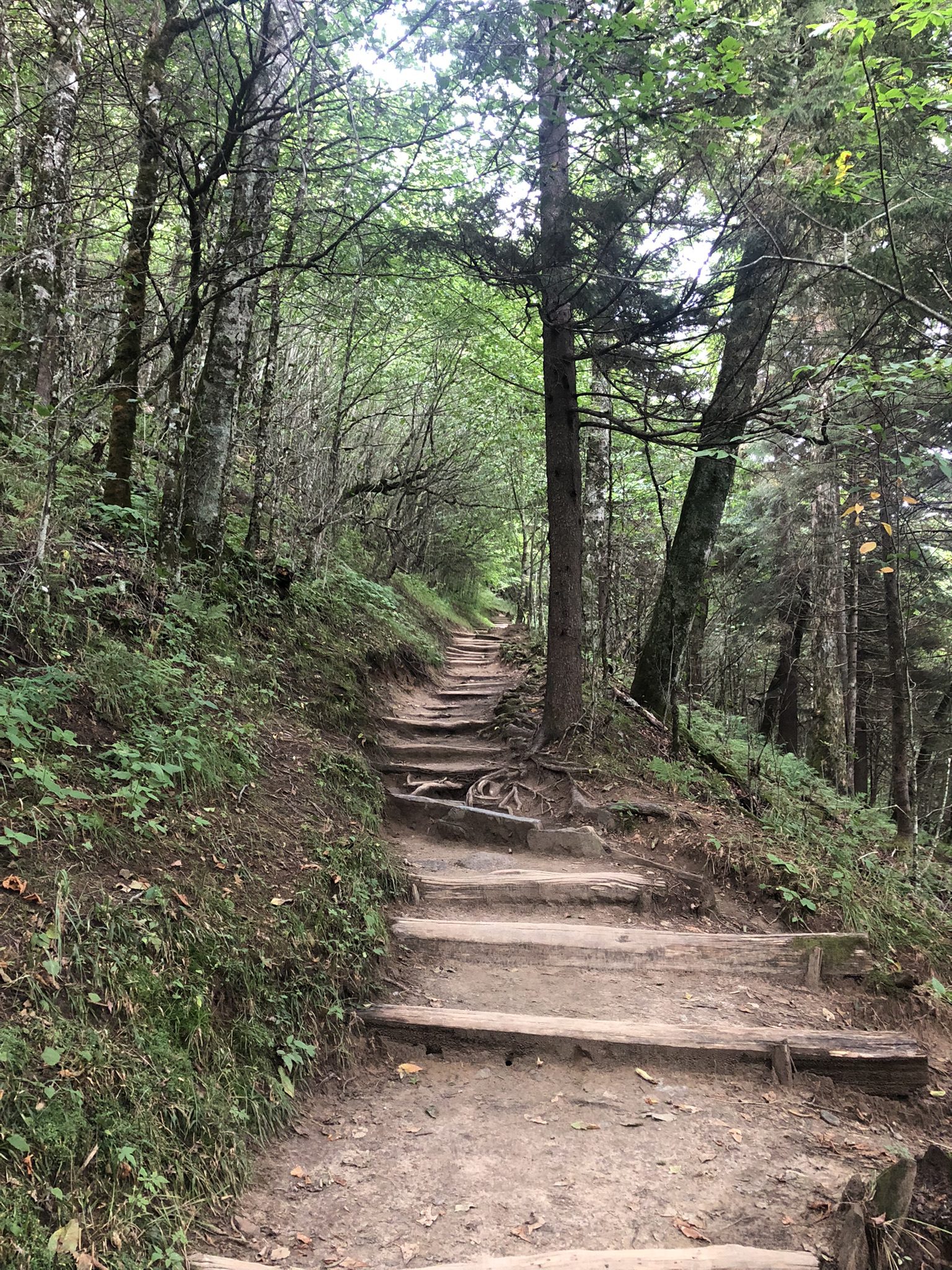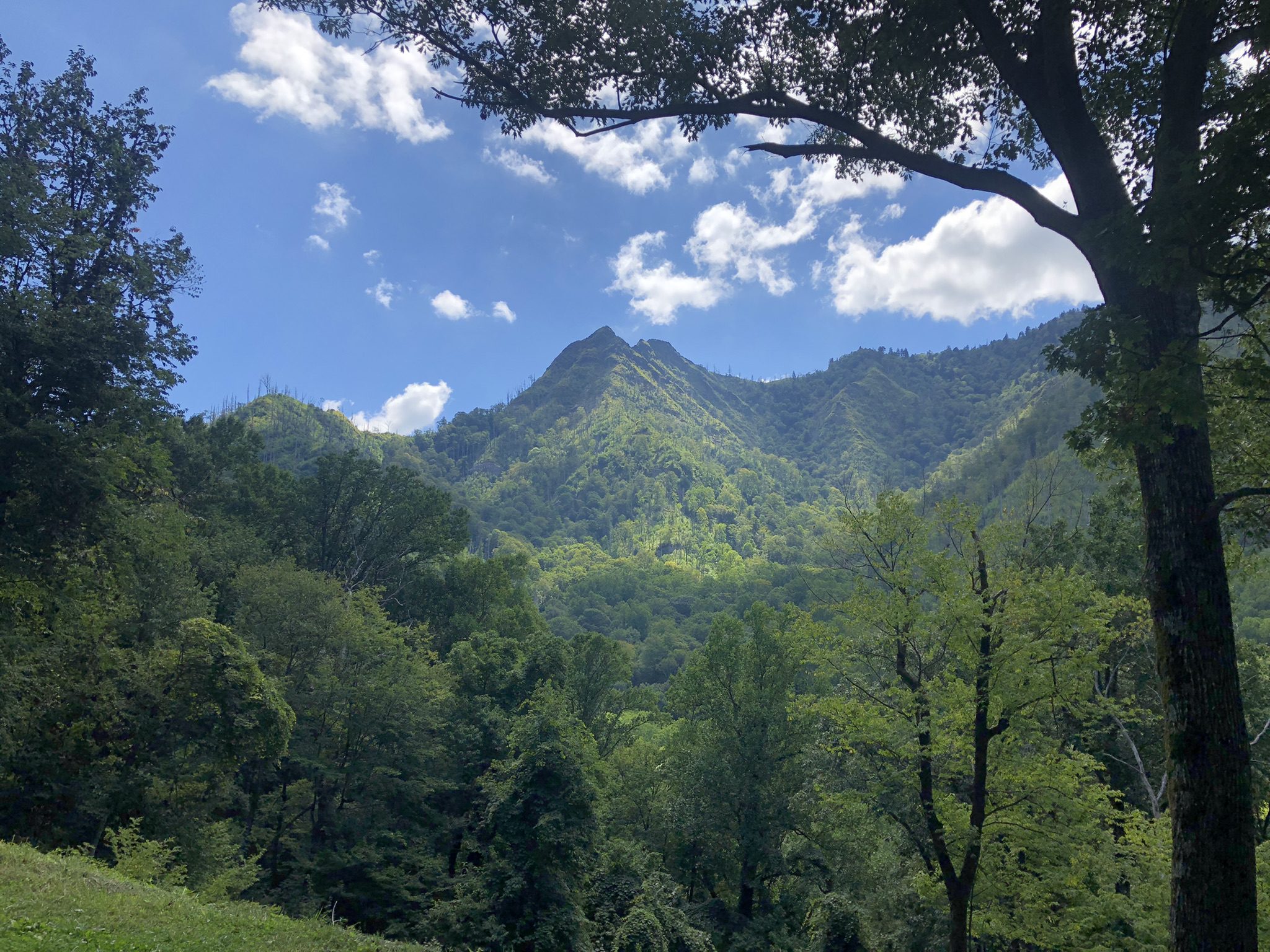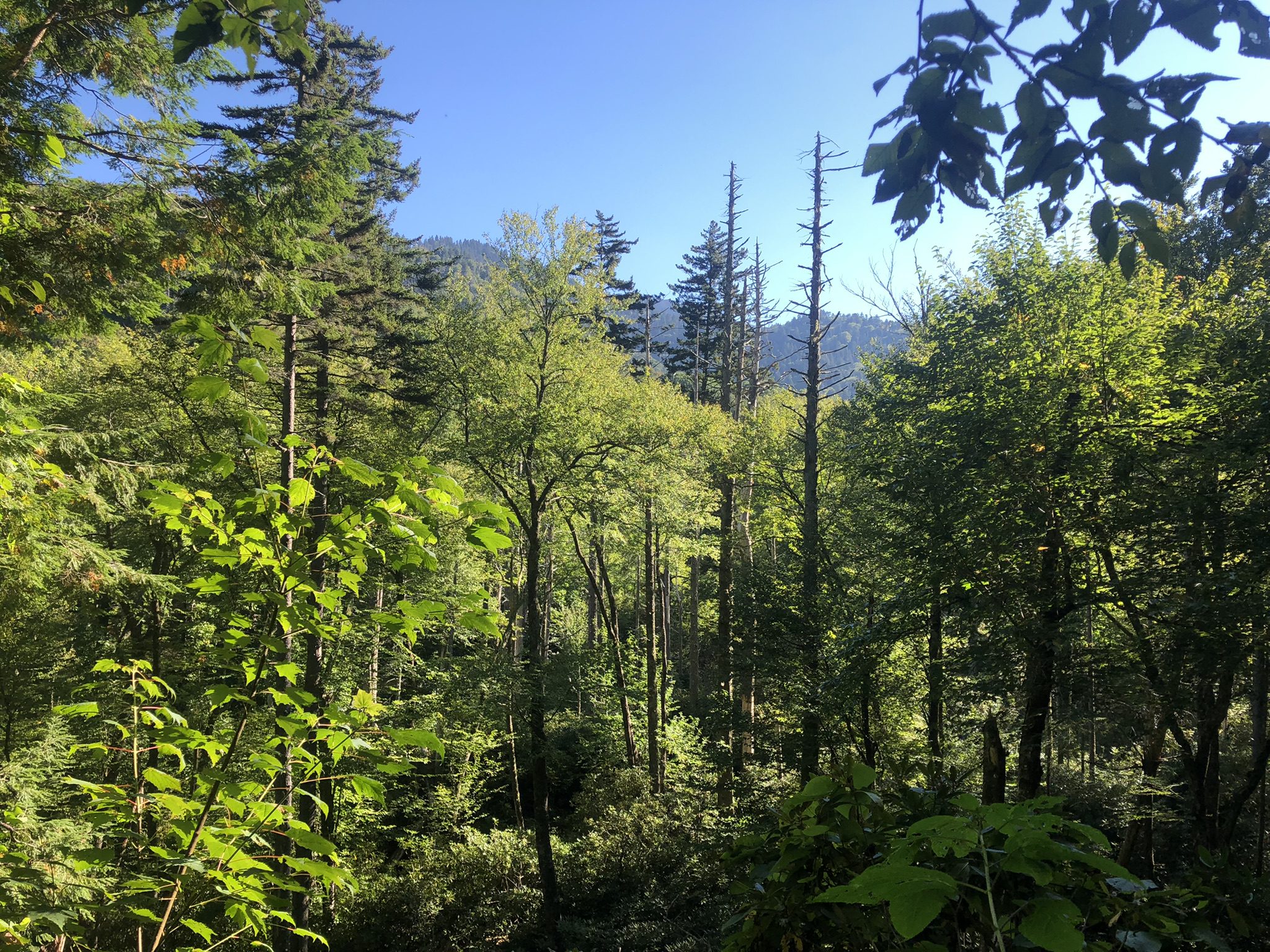
Smoky Mountain National Park
Great Smoky Mountains National Park, located on the border of North Carolina and Tennessee, is a breathtaking natural wonder. It is renowned for its mist-covered mountains, diverse wildlife, and lush forests. This UNESCO World Heritage Site encompasses over 500,000 acres of pristine wilderness, making it the most visited national park in the United States. Visitors can explore its extensive network of hiking trails, which lead to cascading waterfalls, historic structures, and stunning viewpoints. The park is also known for its rich cultural heritage, with preserved Appalachian communities and a wealth of biodiversity, including black bears and a remarkable variety of plant species. The Great Smoky Mountains National Park is a sanctuary for nature enthusiasts and a testament to the beauty of the American wilderness.
Park Information Quick Facts
Location: Tennessee
Park Size: 522,427 acres
Time Needed: 2 Day Highlights, 4-6 Day Full Experience
Best Season: Summer
Must Do: The Appalachian Trail
Lodging: Numerous Camping Sites, Hotels and Cabins Surrounding the Area
Travel: Car, Plane
Top Campsites: Smokemont Campground
Pro Tips: Trails vary from difficulty. If it says moderate be prepared for a fairly rough hike usually filled with lots of up hill climbing.
Visitor Centers
The visitor centers at Great Smoky Mountains National Park serve as essential hubs for both information and recreation, offering a wealth of resources for park-goers. The park features several visitor centers, each located near key entrances or popular areas of the park. These centers provide maps, brochures, and knowledgeable staff to help visitors plan their trips, from hiking trails to scenic drives. They also offer exhibits about the park’s diverse ecosystems, history, and cultural heritage. Some centers, such as the Sugarlands Visitor Center, even feature multimedia presentations and educational programs to enhance the experience.
Plan Your Smoky Mountain Adventure Today!
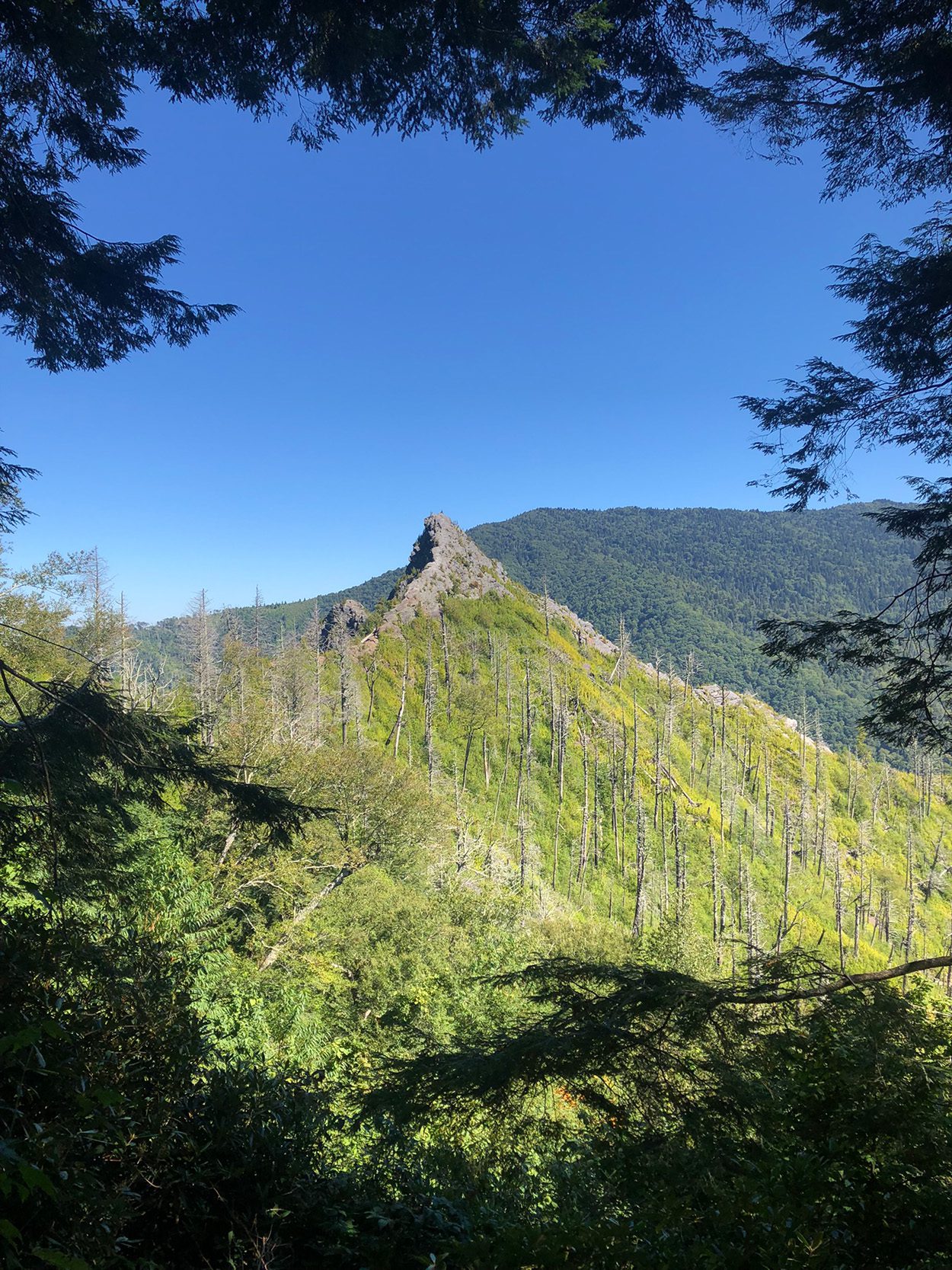
Getting There
How to Travel to Smoky Mountain National Park
Traveling to Great Smoky Mountains National Park is accessible from multiple directions, as the park spans both North Carolina and Tennessee. For those flying, the nearest major airports are in Knoxville, Tennessee, and Asheville, North Carolina, both about an hour or two away from the park by car. Knoxville’s McGhee Tyson Airport (TYS) offers a wide range of flights, while Asheville Regional Airport (AVL) also serves as a convenient gateway, especially for travelers from the southeastern U.S. Once in either city, visitors can rent a car to drive to the park, as public transportation options are limited.
For those coming by car, the park is well-connected by several major highways. The primary access routes include U.S. Highway 441, which runs through the park and connects the towns of Gatlinburg, Tennessee, and Cherokee, North Carolina. The park also has entrances at Oconaluftee Visitor Center, Sugarlands Visitor Center, and the Townsend entrance, each offering easy access to different sections of the park. If driving from nearby cities like Knoxville, Gatlinburg, or Asheville, the roads are typically scenic and provide beautiful views of the surrounding mountains, making the drive itself an enjoyable part of the journey.
"Wilderness is not a luxury but a necessity of the human spirit" - Edward Abbey
Lodging
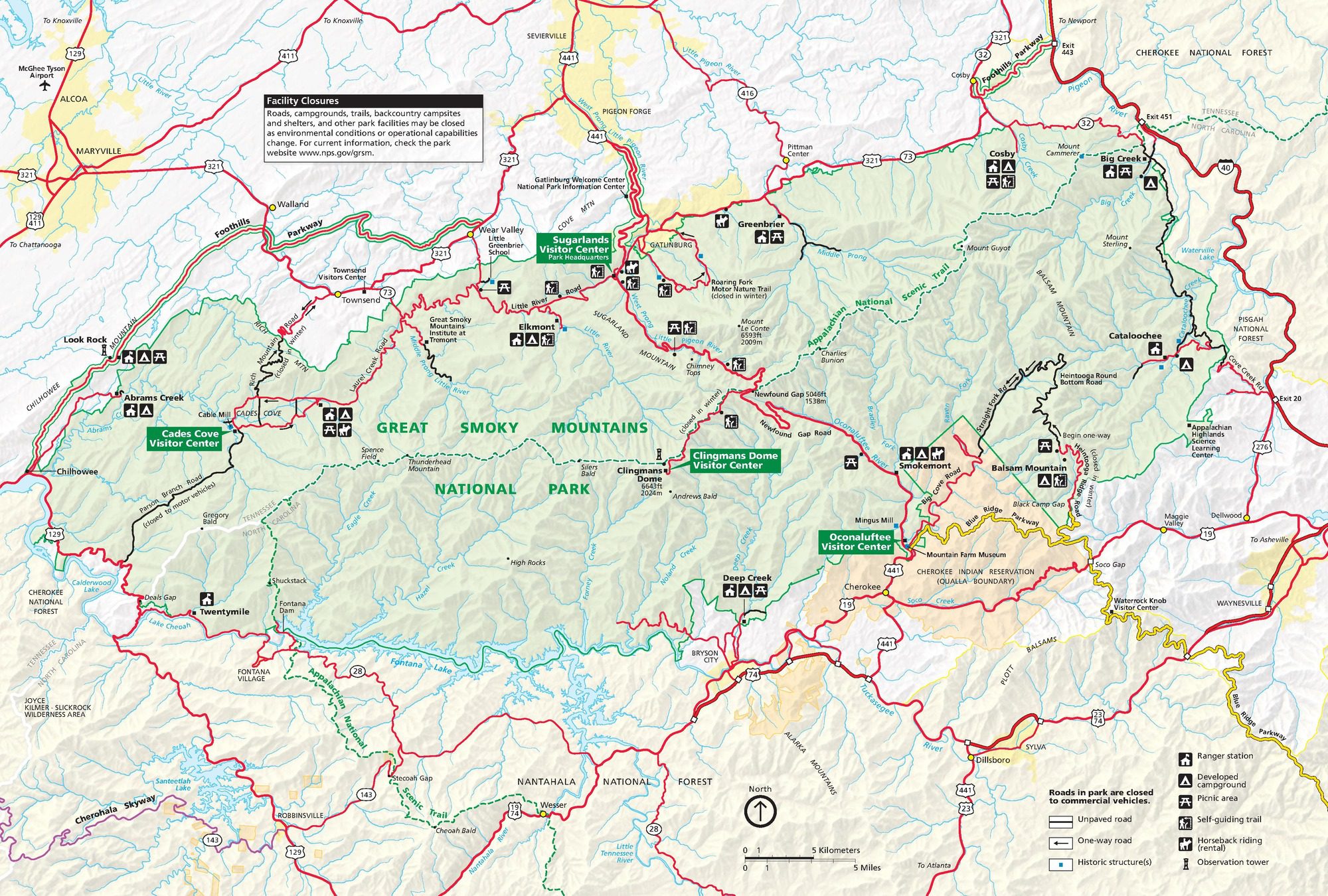
Campsites
The Great Smoky Mountains National Park boasts a plethora of enchanting campsites, each offering a unique blend of natural beauty and tranquility. Nestled within the lush greenery of the Appalachian Highlands, these campsites provide an immersive experience for nature enthusiasts. Whether perched along the serene banks of a babbling mountain stream or tucked into the cool shade of ancient forests, the campgrounds in the park offer a diverse range of settings. Campers can revel in the sounds of rustling leaves, the melodic chorus of songbirds, and the soft murmur of nearby streams. The campgrounds also serve as gateways to a network of hiking trails, allowing visitors to explore the park’s diverse ecosystems, including rich hardwood forests and mist-covered mountain peaks.
Cades Cove Campground:
- Location: Cades Cove loop road (Tennessee side).
- Capacity: 159 sites (tent and RV).
- Amenities: Restrooms, drinking water, picnic tables, fire rings, a camp store, and a dump station.
- Features: This campground is located near the famous Cades Cove, a popular wildlife viewing area and a site with a rich history. It’s ideal for visitors looking to explore the Cove’s hiking trails, historic buildings, and enjoy opportunities to see deer, bears, and wild turkeys.
Elkmont Campground:
- Location: Near the Sugarlands Visitor Center (Tennessee side of the park).
- Capacity: 220 sites (both tent and RV sites).
- Amenities: Restrooms, drinking water, picnic tables, fire rings, and a dump station.
- Features: Elkmont is one of the most popular campgrounds in the park, especially during the summer months when the synchronous fireflies are visible. It’s near the Appalachian Trail, as well as scenic trails and historical sites, including the Elkmont Historic District.
Smokemont Campground:
- Location: Near the Oconaluftee Visitor Center (North Carolina side).
- Capacity: 142 sites (tent and RV).
- Amenities: Restrooms, drinking water, picnic tables, fire rings, and a dump station.
- Features: Smokemont is located at the base of the park’s mountains and offers easy access to the Oconaluftee River, perfect for fishing. It’s also close to the park’s historical sites and hiking trails, such as the Bradley Fork Trail.
Cosby Campground:
- Location: Near the Cosby Entrance (Tennessee side).
- Capacity: 35 sites (tent-only).
- Amenities: Restrooms, drinking water, picnic tables, and fire rings.
- Features: Cosby Campground is in a relatively isolated area, offering a peaceful setting and access to several hiking trails, including the Cosby Nature Trail. It is one of the park’s quieter campgrounds and is ideal for those looking for a more serene camping experience.
Balsam Mountain Campground:
- Location: On the North Carolina side, along the Balsam Mountain Road.
- Capacity: 46 sites (tent-only).
- Amenities: Restrooms, drinking water, picnic tables, and fire rings.
- Features: Situated at a higher elevation (about 5,000 feet), this quieter, more remote campground is ideal for those seeking solitude and cooler temperatures. It’s near the Balsam Mountain Trail and offers access to beautiful mountain views and a variety of wildlife.
Big Creek Campground:
- Location: Near the Big Creek Ranger Station (Tennessee side).
- Capacity: 12 sites (tent-only).
- Amenities: Restrooms, drinking water, picnic tables, and fire rings.
- Features: Big Creek is located in a remote area and offers a true backcountry experience. It’s ideal for hikers and outdoor enthusiasts who want to explore the nearby trails, such as the Big Creek Trail and the Greenbrier section of the park.
Backcountry Campsites
- Location: Spread throughout the park, accessible by hiking trails.
- Capacity: Varies by site (backcountry campsites).
- Amenities: None (primitive camping).
- Features: For those seeking a more rugged experience, the park has over 100 backcountry campsites. These sites are accessible only by foot, offering solitude and the chance to truly immerse yourself in nature. Permits are required for backcountry camping.
Important Notes
- Reservations: Many of the campgrounds within the park require reservations, especially during peak seasons. It’s advisable to check the National Park Service website or call ahead to secure your campsite, as availability can be limited.
- Wildlife Awareness: The Great Smoky Mountains are home to diverse wildlife, including bears. Practice responsible food storage by using bear-resistant containers and following park guidelines to avoid attracting wildlife to your campsite.
- Water Sources: Treat water from natural sources or bring your own. While water is available at most campgrounds, it’s essential to be prepared, especially if venturing on backcountry trails.
- Backcountry Permits: If backpacking or camping in the backcountry, obtain the necessary permits. These permits help the park manage and protect its resources and ensure a safe experience for all visitors.
Camping Tents
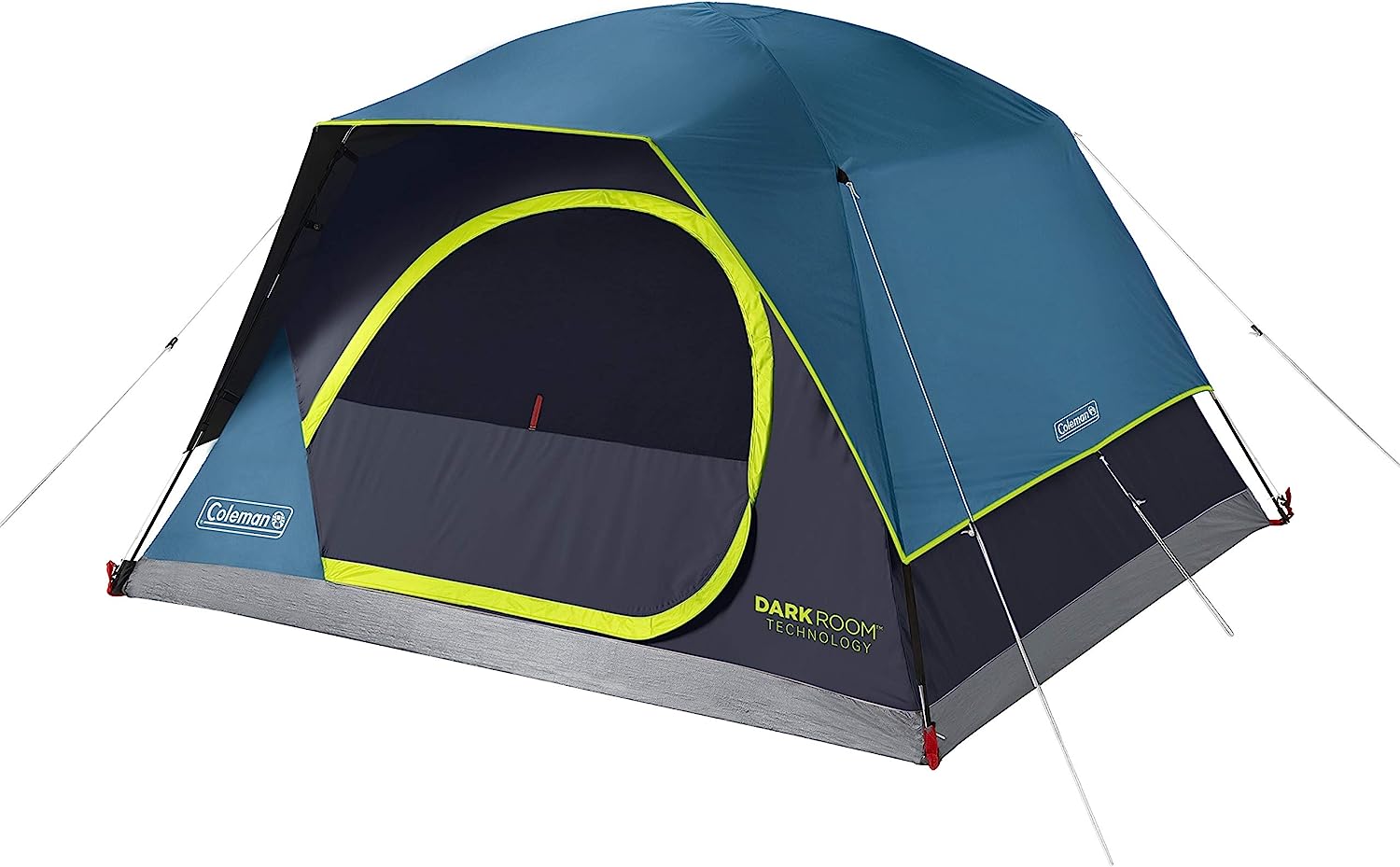
Backpacs

Popular Hiking Trails
Alum Cave Trail
- Length: 4.4 miles (round trip)
- Difficulty: Moderate to strenuous
- Features: This trail climbs to Alum Cave Bluffs, offering breathtaking views of the surrounding mountains and valleys. The trail follows a rocky path with steep sections and some stair-like steps. At the top, hikers are rewarded with a stunning view of the cave’s overhanging rock ledge. It’s one of the park’s most popular and visually rewarding hikes.
Clingmans Dome Trail
- Length: 1 mile (round trip)
- Difficulty: Easy
- Features: This paved trail leads from the Clingmans Dome parking area to the observation tower, which is the highest point in the park (6,643 feet). The trail offers panoramic views of the Smoky Mountains and, on clear days, extends as far as 100 miles. It’s a short but rewarding hike, perfect for visitors who want to experience high-altitude views without a strenuous climb.
Cades Cove Loop Road
- Length: 11 miles (loop)
- Difficulty: Moderate
- Features: This trail follows the Cades Cove Loop Road, which is one of the park’s most famous scenic drives. The trail leads through lush forests, offers views of Cades Cove’s historical structures, and is an excellent spot for wildlife watching, including deer, wild turkeys, and black bears. Visitors can explore several side trails that connect to this loop, including one leading to Abrams Falls.
Laurel Falls Trail
- Length: 1.3 miles (round trip)
- Difficulty: Easy
- Features: The Laurel Falls Trail is the park’s most popular short trail, leading to the park’s largest and most visited waterfall. The paved path is suitable for all skill levels, making it a great option for families and beginners. The waterfall, which cascades 80 feet, is especially beautiful in the spring and summer months when the surrounding foliage is lush.
Abrams Falls Trail
- Length: 5 miles (round trip)
- Difficulty: Moderate
- Features: The trail follows a relatively easy path through a forested area to the scenic Abrams Falls, a 20-foot waterfall. The trail features streams and creek crossings, and visitors can take in beautiful views of the waterfall from an observation deck. It is a great hike for those looking for a peaceful day with the reward of a picturesque waterfall.
Oconaluftee River Trail
- Distance: 3 miles (one way)
- Difficulty: Easy
Hyatt Ridge Trail
- Distance: 5 miles (roundtrip)
- Difficulty: Moderate
Forney Ridge Trail
- Distance: 3.5 miles (one way)
- Difficulty: Moderate
The Jumpoff Trail
- Length: 6 miles (round trip)
- Difficulty: Moderate
- Features: This trail leads to a stunning viewpoint known as The Jumpoff, where hikers can enjoy spectacular vistas of the surrounding mountains and valleys. The trail passes through rich forests and rocky outcroppings and is less crowded than some of the more popular hikes, making it ideal for those seeking solitude.
Baskins Creek Falls Trail
- Length: 3.1 miles (round trip)
- Difficulty: Moderate
- Features: This trail leads to a lovely waterfall located off the beaten path in the park. The trail traverses through dense forest and offers views of the creek and surrounding vegetation. Baskins Creek Falls is a beautiful spot, and the hike is less crowded, providing a more secluded experience compared to some of the other waterfalls in the park.
Grotto Falls Trail
- Distance: 2.6 miles (roundtrip)
- Difficulty: Moderate
Charlie’s Bunion Trail
- Distance: 8 miles (roundtrip)
- Difficulty: Moderate
Porters Creek Trail
- Distance: 4 miles (roundtrip)
- Difficulty: Moderate
Deep Creek Trail
- Length: 4.5 miles (round trip)
- Difficulty: Moderate
- Features: The Deep Creek Trail follows a picturesque creek, passing by a series of small waterfalls and offering scenic views of the Smoky Mountains. The trail is popular for its stunning beauty, with ample opportunities for picnicking and wildlife spotting. It is also known for being one of the park’s more peaceful hikes, away from larger crowds.
Trillium Gap Trail
- Distance: 7.2 miles (roundtrip)
- Difficulty: Moderate
Chimney Tops Trail
- Length: 4 miles (round trip)
- Difficulty: Strenuous
- Features: This challenging trail leads to the iconic Chimney Tops peaks, which provide panoramic views of the surrounding mountains. The trail features steep, rocky terrain and a series of switchbacks, making it a strenuous hike, but the views from the top are well worth the effort. Hikers must scramble up some rock outcroppings to reach the summit, so it’s recommended for experienced hikers.
Mount LeConte Trail
- Length: 11 miles (round trip)
- Difficulty: Strenuous
- Features: One of the park’s most famous and challenging hikes, the Mount LeConte Trail leads to the summit of Mount LeConte, the third-highest peak in the Smoky Mountains. The trail offers fantastic panoramic views of the surrounding mountains, and those who reach the top can enjoy the LeConte Lodge, a historic lodge that offers rest and food to visitors. The trail is a strenuous climb but offers an unforgettable experience.
Hiking Trails in Smoky Mountain National Park
Hiking in Great Smoky Mountains National Park is an unforgettable experience, offering over 800 miles of trails that wind through lush forests, cascading waterfalls, and breathtaking mountain vistas. The park’s extensive trail network includes options for every skill level, from easy, family-friendly paths like the Gatlinburg Trail and Laurel Falls Trail to more challenging routes like the Alum Cave Trail and Mount LeConte. Each trail provides a unique opportunity to connect with the park’s diverse ecosystems, which are home to a rich variety of plants, animals, and geological features. Hikers can enjoy everything from moss-covered creek beds and blooming wildflowers to sweeping views of the Appalachian Mountains.
One of the park’s highlights is its array of waterfalls, many of which are accessible via well-marked trails. Trails like Abrams Falls and Grotto Falls combine manageable distances with stunning scenery, making them popular choices for visitors. More adventurous hikers can tackle trails leading to higher elevations, such as Clingmans Dome or Chimney Tops, where the reward is panoramic views of the Smoky Mountain range. For those seeking solitude, the park’s backcountry trails provide a chance to explore less-frequented areas, offering peace and a deeper connection with nature.
Wildlife at the Park
The wildlife in Great Smoky Mountains National Park is one of its most celebrated features, drawing millions of visitors each year to experience its rich biodiversity. The park is home to over 19,000 documented species, with scientists estimating that an additional 80,000 to 100,000 species may inhabit the area. This incredible variety of life is due to the park’s range of elevations, abundant rainfall, and the presence of old-growth forests, creating diverse habitats. From the lush valleys to the high mountain peaks, the Smokies support an impressive array of mammals, birds, reptiles, amphibians, and fish.


One of the most iconic animals in the park is the black bear, with an estimated population of 1,900. Visitors often hope to spot these magnificent creatures in their natural habitat, but safety precautions are essential when encountering wildlife. Other notable mammals include white-tailed deer, elk, coyotes, and red foxes, which can often be seen grazing in open fields or foraging in the forests. Bird enthusiasts flock to the Smokies to observe over 240 species of birds, including warblers, woodpeckers, and peregrine falcons. The park is also known for its rich diversity of salamanders, earning it the nickname “Salamander Capital of the World.”

Gear We Used


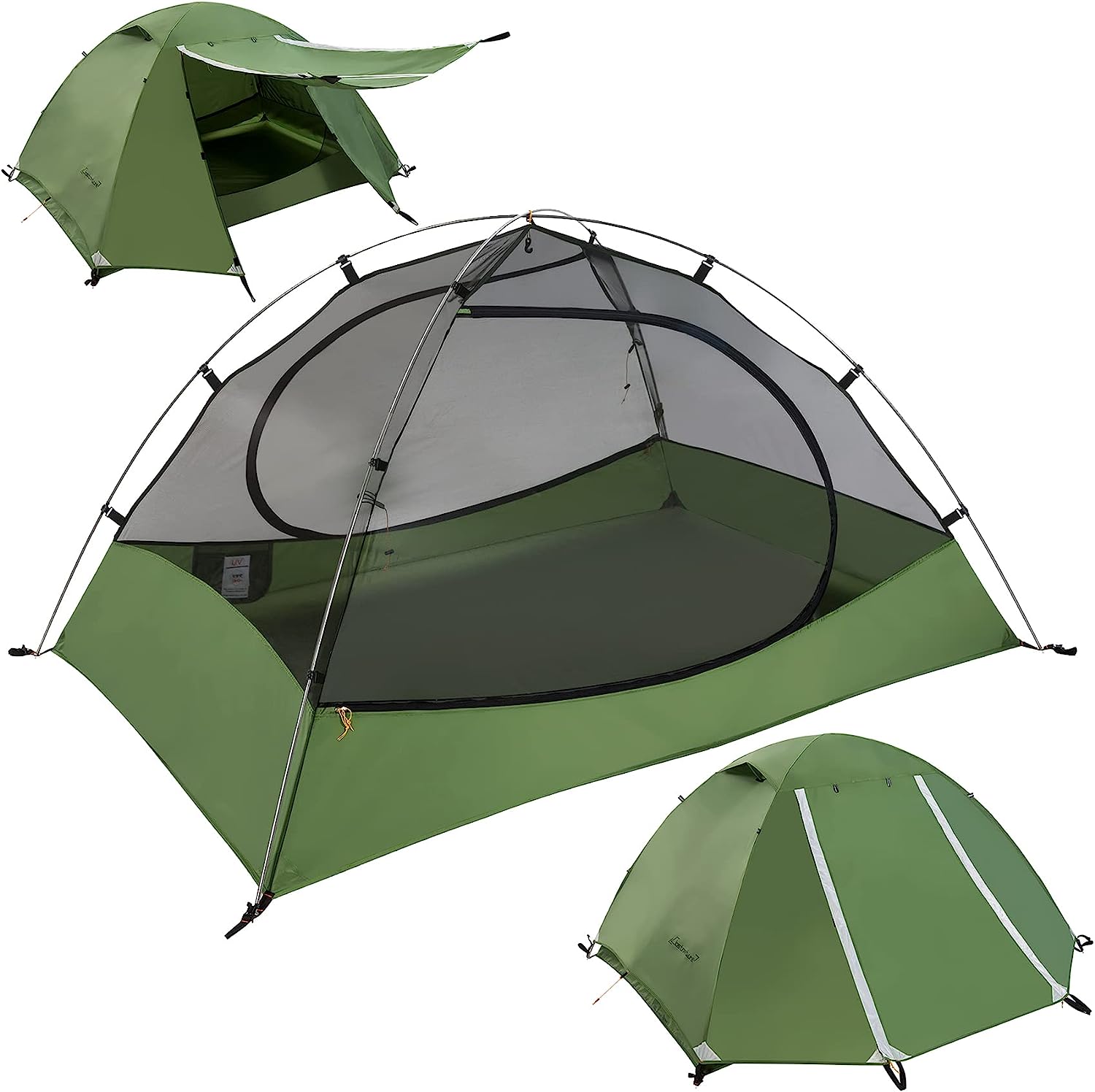


Must Do’s
Elkmont Historic District
Elkmont was established in the early 20th century as a logging town, and later, it became a popular resort community. Over time, the area fell into disuse, and many of the cabins and buildings were left behind. Today, the National Park Service has preserved some of the structures in Elkmont, and visitors can explore the historic district.
Appalachian Trail
Hiking the Appalachian Trail through the Great Smoky Mountains National Park is a transformative and awe-inspiring experience. The trail, which stretches over 2,000 miles from Georgia to Maine, traverses some of the most stunning and challenging terrains in the eastern United States.
Chimney Tops Trail
This moderately strenuous trail, known for its panoramic vistas, begins with a gradual ascent through a lush, diverse forest. As hikers progress, the trail becomes steeper, leading to a series of rocky outcrops that offer breathtaking views of the surrounding mountains and valleys. The final push to the summit involves a rugged climb, but the sight from the Chimney Tops is truly spectacular, making it all worthwhile.
Sight Seeing
The Great Smoky Mountains National Park, situated on the border between North Carolina and Tennessee, offers a breathtaking array of natural wonders and scenic beauty. Towering peaks, lush forests, and cascading waterfalls create a stunning backdrop for visitors. Clingmans Dome, the highest point in the park, provides panoramic views of the surrounding landscapes.
Smoky Mountain National Park History
The history of Great Smoky Mountains National Park is a story of natural beauty, cultural heritage, and dedicated conservation efforts. Long before it became a national park, the region was home to the Cherokee people, who lived in harmony with the land for centuries. They called the area “Shaconage,” meaning “land of the blue smoke,” in reference to the mist that often hangs over the mountains. The Cherokee left a rich cultural legacy, including trails and legends that are still celebrated today. In the early 19th century, European settlers began to move into the region, establishing small farms, logging camps, and mountain communities.
By the early 20th century, industrial logging threatened the forests of the Smoky Mountains, leading to significant environmental destruction. Recognizing the need to preserve this unique wilderness, local citizens, conservationists, and government officials began advocating for the establishment of a national park. The effort gained momentum in the 1920s, thanks in part to the financial support of philanthropists like John D. Rockefeller Jr., who donated $5 million toward the project. The park officially opened in 1934, becoming the first national park created with land purchased from private owners. Many families who lived in the region were relocated, leaving behind a fascinating array of historical buildings and artifacts that tell the story of mountain life.

